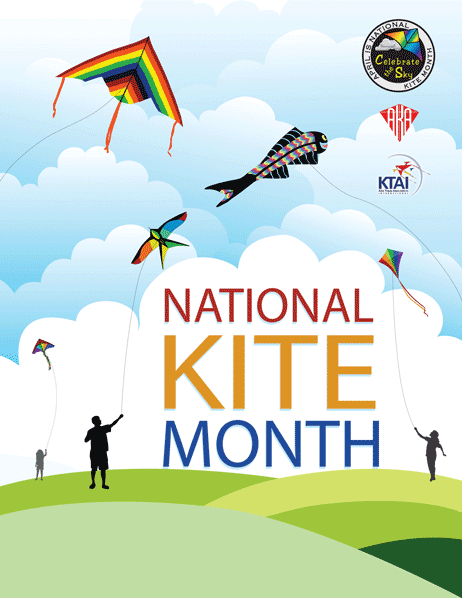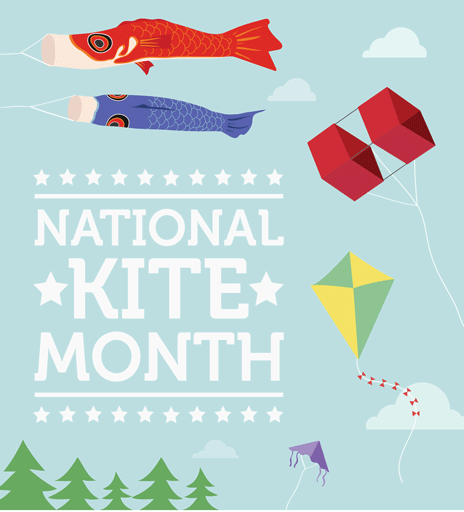National Kite Month on March, 2025: kite flying is d national sport of which country?
March, 2025 is National Kite Month 2025. National Kite Month is coming! National Kite Month is coming!

Truly, the question should be, "In which COUNTRIES....?". The answer is - in many. Kite flying has grown from historical incident of military significance to religious, spiritual, and presently to scientific significance. However, as in most human inventions eastern civilisations of India and China lay their first claim. Japan, Korea, Vietnam, Malaysia, in fact the whole of eastern hemisphere is a hub of RECREATIONAL kite flying. A small writeup on Kite Flying, compiled from various websites, is as follows:
History
Between A.D. 960 and 1126, kite flying became a popular sport in China. The 9th day of the 9th month was a day when kites were flown to banish evil. In Indian literature, kites were mentioned for the first time in " Madhumati" by Manzan, and were called "patang", which is the word still used today
India:
Makar Sankranti (Kite Flying Day) marks the end of a long winter with the return of the sun to the Northern Hemisphere. According to the Hindu astronomy the sun enters the zodiac of Makara (Capricorn). Hence, it is called Uttarayan or Makar Sankranti. The special significance attached to the celebration of Makar sankranti, is Kite Flying. The gods who are believed to have slumbered for six long months are now awake and the portals of heaven are thrown open! The serene blue sky with colorful kites look splendid and since morning to evening remains dotted with vivid splashes of color with kites in a variety of hues, shapes and sizes. The excitement continues with the onset of night. As the sun sets and darkness hovers over, youngsters continue competing each other in supremacy in the sky, now with the paper lanterns tied to their kite-strings. These lanterns known as tukkal swaying at the mild stroke of wind presents a lovely image while some try to cut off these tukkals and enjoy the fun.
"May it be Republic Day or Independence Day or Makar Sakranti or Janamashtami, more and more people in north India are taking to kite flying on such days. In a way, kite flying is becoming a festival by itself. The Indian festival of Makar Sakranti is devoted to kite flying and fighting in some states. This year the festival was celebrated on January 14, with millions of people flying kites all over northern India. The states of Bihar, Jharkhand, Gujarat, and some part of West Bengal, Rajasthan, Andhra Pradesh and the cities of Ahemdabad, Baroda, Jaipur, Dhanbad and Hyderabad are particularly notable for their kite fighting festivals." Kiters duel it out in the skies cutting one another's kited from the skies using glass and chemically coated kite line to assist in severing the kite of an opponent and thus win the battle.
Kite Flying across the world
A major kites festival starts somewhere on the planet every few weeks.
Pakistan: A kite fighting ban imposed by the Pakistan Supreme Court has been effect for several years now due to the number of injuries and deaths that have occurred due to kite flying.
Australian and New Zealand kite festivals are in full swing in the Southern Hemisphere summer. These two locales have produced some of the most innovative modern kites to grace the skies at kite festivals in the past decade. Recently, the Tip-Top Kite Day was held in Christchurch, NZ and featured international kiters in attendance from as far away as The Netherlands. So it is clear that kiting is flourishing in this region as well.
Europe has a number of outstanding festivals: Dieppe France, Bristol in Great Britain, Schveningen in The Netherlands and Fano in Denmark are well known gathering spots for international kite fliers.
North America has a large number of festivals of note: the Niagara International Kite Festival in Niagara Falls, NY; Wildwood in New Jersey; the Smithsonian Kite Festival in Washington, D.C.; Sunfest in Ocean City, Maryland; the Washington State Kite Festival and Dieppe, New Brunswick are among the many events in this continent that attract noted fliers from around the world.
Some interesting Kite-facts
During the American Civil War, kites were used to drop leaflets behind the front lines, urging the other troops to surrender.
The ancient Chinese used kites to ward off evil spirits. Kites were often used to carry messages into the heavens for the Gods. Even today the Chinese regard kites as symbols of good fortune.
In 1848, one of the first suspension bridges in the United States was erected over the Niagara River. The problem of establishing the first line across the raging river was solved by a young boy who flew a kite across the chasm.
It is said that in 200 B.C. Huan Thang of China flew a kite at night to overawe the army of the Han dynasty.
From 100 B.C. to A.D. 500 kites were used for sending signals and to measure the distance of enemy camps.

National Days?
Click on the link below then go to the month you would like. Once there click on the special days link. It has between 10 to 20 special/odd days to celebrate per each month of the year.
Examples: National Weatherperson's Day, Polar Bear Day, First toy store opened day, Make your bed day, Make a hat day, Kite day, Circus day. You get the idea. Loads of fun days to celebrate there.
I have used this before. I hope it is what you are looking for. Enjoy!

Which animal is the main attraction in Assam's Kaziranga National Park?
Kaziranga National Park
Location : Bokakhat (23-kms), Assam.
Nearest Access : Bokakhat
Main Wildlife Found : Rhinos, Tigers, Leopards
Coverage Area : 430-sq-kms
Kaziranga Tour Packages
Kaziranga Lodges & Resorts
About Kaziranga National Park
Located on the banks of the mighty Brahmaputra River in the far North East of India, Assam, Kaziranga National Park covers an area of approximately 430-sq-kms with its swamps and tall thickets of elephant grass making it the ideal habitat for the Indian One-Horned Rhino. Due to limitless poaching of this prehistoric survivor, the Kaziranga National Park was declared a wildlife sanctuary in 1940.
Major Wildlife Attractions of Kaziranga Wildlife Sanctuary
Beside ofcourse the great one horned Indian Rhino, the other major wild attractions include a large population of Indian Elephants, Indian Bison, Swamp Deer or Barasingha, Hog Deer, Sloth Bears, Tigers, Leopard Cats, Jungle Cats, Otters, Hog Badgers, Capped Langurs, Hoolock Gibbons, Wild Boar, Jackal, Wild Buffalo, Pythons, Monitor Lizards, etc.
Kaziranga National Park is a birding paradise; the grasslands are a raptor country that can be seen on safari makes a remarkable experience. These include the Oriental Honey Buzzard, Black-Shouldered Kite, Black Kite, Brahminy Kite, Pallas's Fishing Eagle, White Tailed Eagle, Grey-Headed Fishing Eagle, Himalayan Griffon, etc. Huge numbers of migratory birds descend on the parks lakes and marshy areas during winters, including Greylag Geese, Bar-Headed Geese, Ruddy Shelduck, Gadwall, Falcated Duck, Red-Crested Pochard and Northern Shoveller.
Other Attractions In Kaziranga
Elephant Safari : The vast open country makes Kaziranga National Park very accessible and wildlife viewing fairly pleasurable. Here one can leave in the early hours of the dawn for an elephant-back-ride. Authorized and trained Mahouts who guide visitors through the park train the Elephants. One could see wild Elephant herds roaming around or Indian Rhinos browse past visitors unconcernedly. Since Kaziranga wildlife Sanctuary is easily accessible, its provides a chance to see animals in the wild at such close quarters, thus making a trip to this National Park a very rewarding experience.
Sightseeing in Kaziranga : Tourists can stroll through the lush coffee and rubber plantations of the nearby Karbi Anglong. Or visit the Karbi villages, meet the Karbi people and observe their way of living. Yiu can also venture through the tea gardens that Assam is so famous for and watch how one gets one's daily cup of tea. Film shows on wildlife can be arranged at the various tourist lodges in Kaziranga, on request.
Best Time to Visit Kaziranga National Park
Kaziranga's visiting season is from mid-November to early April months. During the monsoons, the Brahmaputra River bursts its banks, flooding the low-lying grasslands and causing animals to migrate from one area to another within the Kaziranga National Park.
How to Get there
Air : The nearest airport is situated at Guwahati, which is 217-km away from the park. The other airport is located at Jorhat, 97-km from Kaziranga.
Rail : The nearest railhead is Furkating, situated 75-km away from Kaziranga National Park.
Road : The main gate for Kaziranga Wildlife Sanctuary, at Kohora on the NH-37, consists of a handful of cafes and a small local market. ASTC and private buses stop here on their way to and from Guwahati, Tezpur and Upper Assam. Some private buses also retain a seat quota for Kaziranga passengers.
General Info / Tips
Reservation Authority :Joint Director of Tourism, Kaziranga, P.O Kaziranga National Park, District Jorhat, Assam - 785612
Note :Visiting Kaziranga independently can be expensive due to the two-tier price system, with different entry costs for Indian nationals and foreigners. There are separate charges for elephant safari and jeep rides from the lodges to the park entrance, as well as a system of variable camera fees.










